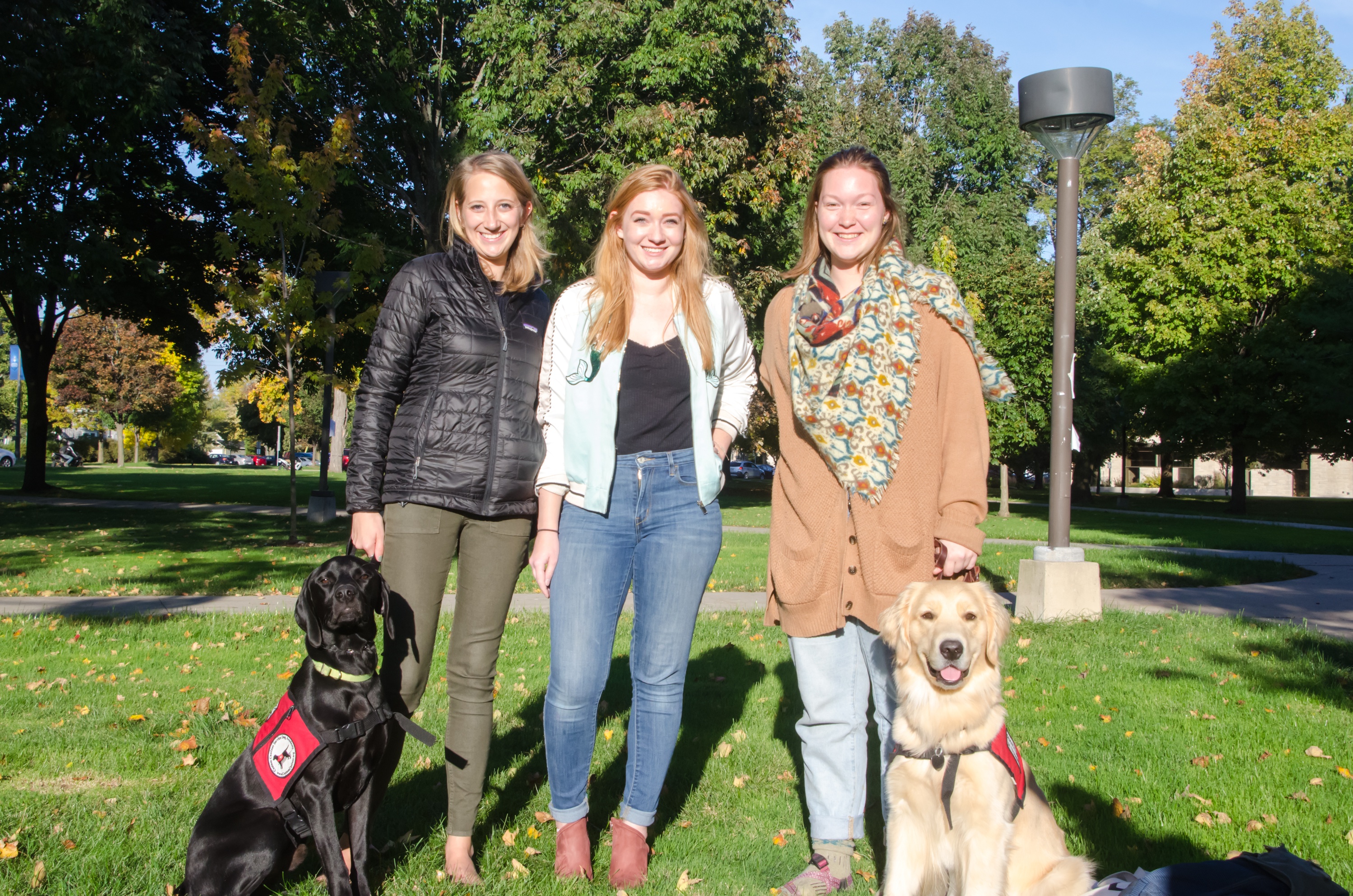Seniors Alexis Dalebroux, Maddie Murray and Rachel Taber with Service Dogs Aero (left) and Nyx (right).
Photo by David Baldwin.
On Thursday, Oct. 12, the People for Animal Welfare (PAW) hosted a presentation in the Diversity Center by seniors Rachel Taber and Alexis Dalebroux about the service animals they are training on campus. Accompanying the students was Nyx, a golden retriever that is training to be a guide dog. The training is through Custom Canines Service Dog Academy, a Madison, Wis. based non-profit, which provides dogs to trainers before sending them to people with disabilities. Taber and Dalebroux emphasized the differences between service dogs and Emotional Support Animals (ESAs), as well as the different kinds of service dogs and the training they have to go through.
ESAs differ from Service Dogs in that they are not required to have any training and, as a result, are not granted the extended rights that service dogs are, including the right to go into almost any public space. Another key difference, as the pair pointed out, is that a service animal frequently performs tasks for the individual with a disability. In contrast, the benefit of an Emotional Support Animal is the animal itself, or the animal’s presence.
Service dogs come in all shapes and sizes, from a dachshund to a golden retriever, and they are just as varied in their functions. Medical alert dogs, as the name suggests, can warn someone prior to a medical emergency such as a seizure or extremely low blood sugar and can get help if necessary. Guide dogs are the most well-known form of service animal and are used to aid the visually impaired in navigating daily tasks and being independent. Service dogs can also help with psychological and emotional disorders, though these are generally thought to be the domain of ESAs. Custom Canines works with the National Guard and several veterans’ organizations to place dogs with those suffering from Post-Traumatic Stress Disorder (PTSD), where they can help calm individuals with extreme anxiety or who are dealing with flashbacks. This is similar to some of the assistance service dogs can perform for individuals with autism, in addition to providing stability and helping those individuals socialize.
The presentation also discussed many misconceptions people have about service dogs. One of the most common misconceptions is that service dogs are simply the pets of those who are either training or benefitting from their services and that anyone can put a vest on their animal and call them a service animal. The presentation on Thursday emphasized that this is not the case and Dean of Students Curt Lauderdale, who attended the presentation, said that any student who does that is simply making life more difficult for those who the policy surrounding service animals was intended to help.
Another common misconception is that it is okay to interact with a service animal while they are in training. It was emphasized repeatedly throughout the presentation that this is not acceptable and makes the job of the trainers even more difficult. “This is detrimental to their training because it is enforcing the idea that they can get attention from strangers and friends while on duty when they should be focusing on their trainers. This can have really big negative effects after being placed because they could get distracted seeking a human and misdirect their owner or miss a medical cue, such as a seizure or low blood sugar. While it seems like a small innocent action it can have very large and dangerous consequences later in the future,” said Taber.
The trainers acknowledged that the dogs are not perfect and part of their training is that they will make mistakes. They said that while some of their reactions to the dogs misbehaving may seem a little bit harsh, the corrections are simply necessary in order to get a dog to listen, such as raising one’s voice in order to overcome the ‘selective listening’ that the dogs use when ignoring commands. The trainers also said that the dogs are allowed to have fun and relax after a long day of work and do not, as many believe, have to be working all day and night. In addition, Taber and Dalebroux pointed out that if a dog is not fit for the environment they are placed into for training, as was the case with a dog named Gunner from this past summer, or if they are not a fit for the program in general, then the dogs are placed into permanent homes and not shelters.
For anyone who is interested in becoming a service dog trainer, the presentation discussed the requirements to do so. There is an application on the Custom Canines website and 30 hours of training are required before being allowed to keep a dog overnight. 50 hours are required before a student is allowed to bring a dog to campus and they are normally shared when the dog is first starting to train. After completion of their training, the service dogs that Custom Canines train are sent to people all across the country in need of a service animal.

